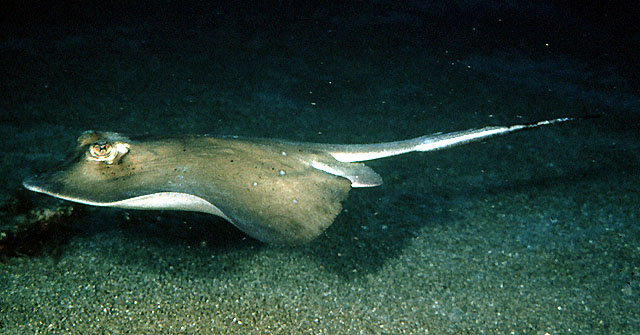| Dasyatidae (Stingrays), subfamily: Neotrygoninae |
| 70 cm TL (male/unsexed) |
|
reef-associated; depth range 0 - 170 m |
| Indo-Pacific: Red Sea (Ref. 9840) and East Africa to Samoa (Ref. 592) and Tonga (Ref. 53797), north to Japan, south to Australia (Ref. 9840). Represented by multiple color morphs in the Indo-Pacific which may be different species (Ref. 9840). |
|
Dorsal spines (total): 0-0; Dorsal soft rays (total): 0-0; Anal spines: 0-0; Anal soft rays: 0-0. Reddish brown with blue centered bright ocelli and scattered black spots dorsally, white ventrally (Ref. 3263). Snout very short and broadly angular; disc angular; tail as long as body with conspicuous black and white rings, and with a short upper caudal finfold but a longer lower one ending well behind tail tip; disc without thorns; usually one sting on tail (Ref. 5578). |
| A solitary species found on sandy bottoms near rocky or coral reefs (Ref. 12951). Usually found in deeper water but moves onto the reef flat and into shallow lagoons at high tide (Ref. 12951). Occasionally covers itself with sand, leaving only its eyes and tail visible (Ref. 37816). Feeds on crabs and shrimps (Ref. 5578). Ovoviviparous (Ref. 50449). The venomous spine can inflict a painful wound (Ref.4690). Caught in very large quantities in the bottom trawl, trammel and fish trap fisheries. Utilized for its meat but of limited value due to its small size (Ref.58048). |
|
Data deficient
(Ref. 96402)
|
| venomous |
|
Source and more info: www.fishbase.org. For personal, classroom, and other internal use only. Not for publication.
Page created by Jen, 05.08.02,
php script by kbanasihan 06/09/2010 ,
last modified by
dsantos, 20/08/10

